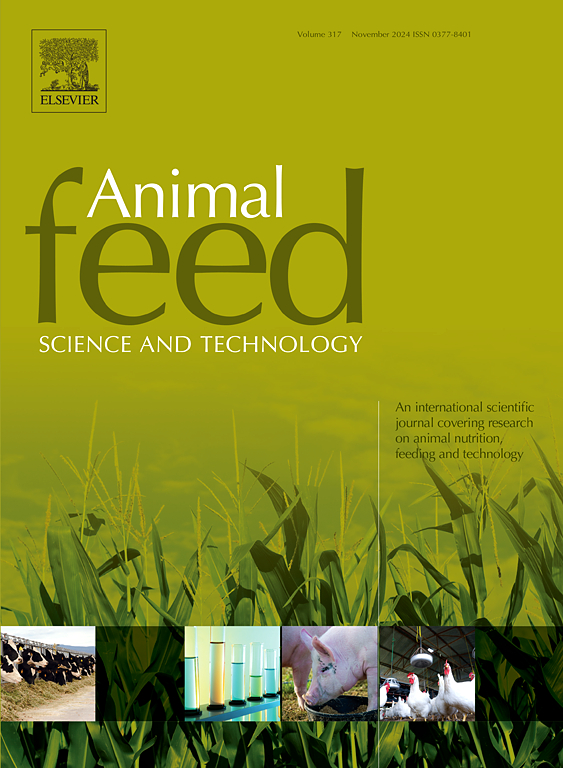蛋氨酸和胆碱调节石斑鱼饲料中血脂的动员,提高饲料效率
IF 2.5
2区 农林科学
Q1 AGRICULTURE, DAIRY & ANIMAL SCIENCE
引用次数: 0
摘要
石斑鱼(Epinephelus lanceolatus)因其生长速度快、抗病能力强、生产价值高,已成为越来越受欢迎的水产养殖候选者。尽管有这些积极的特性,但由于在适当饲料配方所需的具体营养需求方面存在广泛的知识差距,其作为水产养殖物种的潜力受到限制。蛋氨酸是饲料原料中必需的营养物质,在鱼类营养中起着重要作用。其复杂的代谢表明其需要量可能受到其他营养物质的影响,如类维生素化合物胆碱。本研究旨在探讨蛋氨酸和胆碱在调节石斑鱼幼鱼血脂动员中的相互作用及其对饲料效率的影响。研究人员测试了两组饮食:一组是固定的蛋氨酸和不同的胆碱水平,另一组是固定的胆碱(2.71 mg/g)和不断增加的蛋氨酸水平。蛋氨酸和胆碱都影响FCR,这似乎是由能量底物的利用介导的,伴随着循环低密度脂蛋白(LDL)和甘油三酯(TAG)的变化。这些结果似乎与提高脂质向生长组织的动员所获得的能量有关,从而通过增加饲粮蛋氨酸和胆碱来提高饲料效率。综上所述,建议在棘鱼幼鱼饲粮中添加不低于12.7 mg/g和4.3 mg/g的蛋氨酸和胆碱。鉴于这些结果表明胆碱和蛋氨酸水平改变了脂质动员,它们提高了捕获高脂质水平对该物种的生长和效率影响的潜力,而不是以前发现的最佳脂质水平。本文章由计算机程序翻译,如有差异,请以英文原文为准。
Dietary methionine and choline mediate mobilisation of plasma lipids to improve feed efficiency for the diets of giant grouper (Epinephelus lanceolatus)
Giant grouper (Epinephelus lanceolatus) has become an increasingly popular candidate for aquaculture due to its high growth rates, disease resistance, and high production value. Despite these positive attributes its potential as an aquaculture species is limited by extensive knowledge gaps in its specific nutrient requirements needed for appropriate feed formulation. Methionine, an essential nutrient in feed ingredients, plays an important role in fish nutrition. Its complex metabolism suggests that its requirement may be influenced by other nutrients, such as the vitamin-like compound choline. This study aimed to investigate the interaction between dietary methionine and choline in regulating plasma lipid mobilisation, and how this affects feed efficiency in juvenile giant grouper. Two series of diets were tested: one with a constant methionine and varying choline levels, and another with a fixed choline (2.71 mg/g) and increasing levels of methionine. Both methionine and choline affected FCR, which appears to have been mediated by the utilisation of energy substrates, with shifts in circulating low-density lipoproteins (LDL), and triglycerides (TAG). These results appear to be related to energy derived from improved mobilisation of lipids to growing tissue, resulting in improved feed efficiency with increasing dietary methionine and choline. From this investigation, it is recommended that juvenile E. lanceolatus diets are supplemented with both dietary methionine and choline no less than 12.7 mg/g and 4.3 mg/g, respectively. Given that these results demonstrate that choline and methionine levels alter lipid mobilisation, they raise the potential to capture the growth and efficiency effects of higher lipid levels than previously found optimal for this species.
求助全文
通过发布文献求助,成功后即可免费获取论文全文。
去求助
来源期刊

Animal Feed Science and Technology
农林科学-奶制品与动物科学
CiteScore
6.00
自引率
6.20%
发文量
266
审稿时长
3 months
期刊介绍:
Animal Feed Science and Technology is a unique journal publishing scientific papers of international interest focusing on animal feeds and their feeding.
Papers describing research on feed for ruminants and non-ruminants, including poultry, horses, companion animals and aquatic animals, are welcome.
The journal covers the following areas:
Nutritive value of feeds (e.g., assessment, improvement)
Methods of conserving and processing feeds that affect their nutritional value
Agronomic and climatic factors influencing the nutritive value of feeds
Utilization of feeds and the improvement of such
Metabolic, production, reproduction and health responses, as well as potential environmental impacts, of diet inputs and feed technologies (e.g., feeds, feed additives, feed components, mycotoxins)
Mathematical models relating directly to animal-feed interactions
Analytical and experimental methods for feed evaluation
Environmental impacts of feed technologies in animal production.
 求助内容:
求助内容: 应助结果提醒方式:
应助结果提醒方式:


